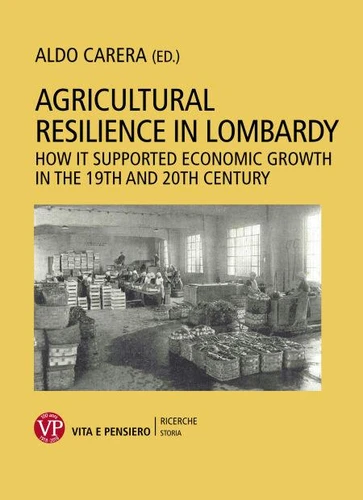Agricultural Resilience In Lombardy. How it Supported Economic Growth in the 19th and 20th Century
Par :Formats :
Disponible dans votre compte client Decitre ou Furet du Nord dès validation de votre commande. Le format PDF est :
- Compatible avec une lecture sur My Vivlio (smartphone, tablette, ordinateur)
- Compatible avec une lecture sur liseuses Vivlio
- Pour les liseuses autres que Vivlio, vous devez utiliser le logiciel Adobe Digital Edition. Non compatible avec la lecture sur les liseuses Kindle, Remarkable et Sony
 , qui est-ce ?
, qui est-ce ?Notre partenaire de plateforme de lecture numérique où vous retrouverez l'ensemble de vos ebooks gratuitement
Pour en savoir plus sur nos ebooks, consultez notre aide en ligne ici
- Nombre de pages160
- FormatPDF
- ISBN978-88-343-3460-7
- EAN9788834334607
- Date de parution27/11/2018
- Protection num.Digital Watermarking
- Taille2 Mo
- Infos supplémentairespdf
- ÉditeurVita e pensiero
Résumé
Has the agricultural system, and in particular that of Lombardy, been able to face reforms and epochal changes? And if so, in which forms and with which outcomes? The book deals with the complex challenge of reconstructing some moments of transformation of Lombard agriculture, capturing the factors of resilience and not only those of stagnation. From the end of the eighteenth century, during the Austrian and French dominations, the Lombard agricultural world, faced with the effects of legislative reforms and production crises, experienced an ability of the system to adapt to change and, then, to renew itself in terms of crops, contractual relationships and social aspects but also new sectors linked to industry or services.
Despite the long-term conservation of economic and social relations, one part of Lombard agriculture was able to seize renewal opportunities. This connotation is kept alive throughout the nineteenth and twentieth centuries and is closely linked to the role of some institutions and social groups that were particularly active in the dissemination of agronomic knowledge, technical innovation and management of private and collective resources.
Despite the long-term conservation of economic and social relations, one part of Lombard agriculture was able to seize renewal opportunities. This connotation is kept alive throughout the nineteenth and twentieth centuries and is closely linked to the role of some institutions and social groups that were particularly active in the dissemination of agronomic knowledge, technical innovation and management of private and collective resources.
Has the agricultural system, and in particular that of Lombardy, been able to face reforms and epochal changes? And if so, in which forms and with which outcomes? The book deals with the complex challenge of reconstructing some moments of transformation of Lombard agriculture, capturing the factors of resilience and not only those of stagnation. From the end of the eighteenth century, during the Austrian and French dominations, the Lombard agricultural world, faced with the effects of legislative reforms and production crises, experienced an ability of the system to adapt to change and, then, to renew itself in terms of crops, contractual relationships and social aspects but also new sectors linked to industry or services.
Despite the long-term conservation of economic and social relations, one part of Lombard agriculture was able to seize renewal opportunities. This connotation is kept alive throughout the nineteenth and twentieth centuries and is closely linked to the role of some institutions and social groups that were particularly active in the dissemination of agronomic knowledge, technical innovation and management of private and collective resources.
Despite the long-term conservation of economic and social relations, one part of Lombard agriculture was able to seize renewal opportunities. This connotation is kept alive throughout the nineteenth and twentieth centuries and is closely linked to the role of some institutions and social groups that were particularly active in the dissemination of agronomic knowledge, technical innovation and management of private and collective resources.





